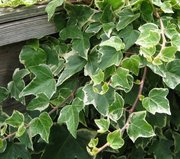Ivy
|
|
- For other uses, see Ivy (disambiguation).
| Hedera | ||||||||||||
|---|---|---|---|---|---|---|---|---|---|---|---|---|
| Missing image Hedera_hibernica1.jpg Hedera hibernica shoot with flower buds | ||||||||||||
| Scientific classification | ||||||||||||
| ||||||||||||
| Species | ||||||||||||
|
See text |
Hedera (English name ivy (plural, ivies) is a genus of about 10 species of climbing or ground-creeping evergreen woody plants in the family Araliaceae, native to the Atlantic Islands, Europe, North Africa and across Asia east to Japan. On suitable surfaces (trees and rock faces), they are able to climb to at least 25-30 m above the basal ground level.
Hedera_hibernica2.jpg
They have two leaf types, with palmately lobed juvenile leaves on creeping and climbing stems, and unlobed cordate adult leaves on fertile flowering stems exposed to full sun, usually high in the crowns of trees or the top of rock faces. The juvenile and adult shoots also differ, the former being slender, flexible and scrambling or climbing with small roots to affix the shoot to the substrate (rock or tree bark), the latter thicker, self-supporting, and without roots. The flowers are produced in late autumn, individually small, in 3-5 cm diameter umbels, greenish-yellow, and very rich in nectar, an important late food source for bees and other insects; the fruit are small black berries ripening in late winter, and are an important food for many birds, though poisonous for man. The seeds are dispersed by birds eating the fruit. The leaves are eaten by the larvae of some species of Lepidoptera such as Small Dusty Wave, Swallow-tailed Moth, Willow Beauty and Lesser Broad-bordered Yellow Underwing.
Species
The species are all allopatric and closely related, and all have on occasion been treated as varieties or subspecies of H. helix, the first species described. Several additional species have been described in the southern parts of the former USSR, but are not regarded as distinct by most botanists.
- Hedera algeriensis - Algerian ivy. Northwest Africa.
- Hedera azorica - Azores ivy. Azores.
- Hedera canariensis - Canaries ivy. Canary Islands.
- Hedera colchica - Caucasian ivy or Persian ivy. Northern Turkey to Iran.
- Hedera helix - Common or English ivy. Western & central Europe, except for the Atlantic coasts.
- Hedera hibernica - Atlantic ivy. Atlantic coastal areas of Europe from Scotland & Ireland to Portugal.
- Hedera maderensis - Madeiran ivy. Madeira.
- Hedera nepalensis - Himalayan ivy. Himalaya, China, Taiwan.
- Hedera pastuchowii - Pastuchov's ivy. Central Asia (southern states of the former USSR).
- Hedera rhombea - Japanese ivy. Japan.
English_Ivy_Berries.jpg
Efeu.jpg
Uses & cultivation
Ivies are very popular in cultivation within their native range, both for attracting wildlife, and for their evergreen foliage; many cultivars with variegated foliage (photo, right) and/or unusual leaf shape have been selected. They are particularly valuable for covering unsightly walls. Ivies have however proved to be a serious invasive weed in the parts of North America where winters are not severe, and their cultivation there is now discouraged in many areas.
Much has been argued as to whether ivy climbing trees will harm the tree or not; the consensus in Europe is that they do not harm trees significantly, though they may compete for ground nutrients and water to a small extent, and trees with a heavy growth of ivy can be more liable to windthrow. Problems are greater in North America, where trees may be overwhelmed by the ivy to the extent they are killed; this could be because ivy in North America, being introduced, is without the natural pests and diseases that control its vigour in its native areas.
Similar concerns are expressed about damage to walls. Here it is normally considered that a soundly mortared wall is impenetrable to the climbing roots of ivy and will not be damaged, and is also protected from further weathering by the ivy keeping rain off the mortar. Walls with already weak or loose mortar may however be badly damaged, as the ivy is able to root into the weak mortar and further break up the wall.
The name Ivy has also been applied to several other unrelated plants. See the disambiguation page Ivy for details.
In typography, hedera is the name of a horticultural dingbat shaped like an ivy leaf.
da:Vedbend (Hedera)

